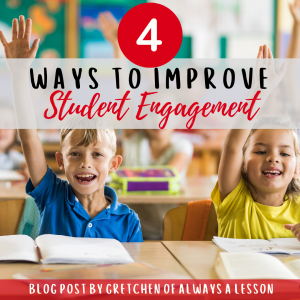4 Ways to Improve Student Engagement
Student engagement in the classroom has a powerful ripple effect. When students are engaged at deep levels it means they have more opportunities to transfer, digest, and store knowledge. Student learning outcomes increase as well as their confidence to tackle challenging academics.
This post will cover 4 aspects of student engagement to consider when designing your lessons.
Motivation
 Students are not going to be interested in engaging in learning activities in the classroom if the teacher has not taken time to explain how the content relates to their life. When students are motivated to learn, they will not only comply and complete the activity, but they will be willingly engage at a high level. In order to motivate students, teachers must know their students’ interests, hobbies, personalities, etc. This allows the teacher to present the information in an interesting way where students see the benefit for learning the material. Tapping into motivation first, allows students to warm up to the idea of learning and then fully engage during the lesson.
Students are not going to be interested in engaging in learning activities in the classroom if the teacher has not taken time to explain how the content relates to their life. When students are motivated to learn, they will not only comply and complete the activity, but they will be willingly engage at a high level. In order to motivate students, teachers must know their students’ interests, hobbies, personalities, etc. This allows the teacher to present the information in an interesting way where students see the benefit for learning the material. Tapping into motivation first, allows students to warm up to the idea of learning and then fully engage during the lesson.
Systems
Engagement can go awry when systems are not in place before the activity begins. Teachers need to plan intentionally, paying close attention to pacing, volume level, movement and expectations for what students are to produce. Once the plan is in place, the teacher must include those details when explaining how students will be engaging with the learning material. Once students engage, the teacher must hold students accountable for meeting the expectations. This ensures the lesson progresses as planned and misbehaviors do not get out of hand. Clear, well planned systems create time time for learning.
Alignment
It can be challenging to pass up on really fun activities shared on social media. The reality is that many activities may be highly engaging but don’t actually align well to the content. This doesn’t mean teachers can’t do interesting activities with students. Alignment doesn’t equate to boring. Teachers can have fun and be creative, but it is only beneficial when it aligns to the content being taught. Carefully choosing engagement opportunities that are aligned mean that the backwards design method is used when planning. Teachers know which standard they are covering, pick a piece of the standard to teach in a single objective, and plan the assessment o determine if students were effectively able to gain the skills taught. Then, it is time to plan activities for engagement. When teachers are clear on “what” they are teaching, the “how” becomes easier to plan. If a fun engagement idea is found but doesn’t align, teachers can save it for another time. It is imperative that how students engage in class allows them to deepen understanding of the concept being taught.
Evergreen
It can be daunting to come up with new and different engagement ideas all year long. The good news is that teachers can use and reuse engagement strategies in all subject areas. The benefit is two-fold. First, teachers save time by reusing an engagement strategy previously used. Secondly, time is saved on the students part because they do not need to learn a new strategy which takes time away from learning. Since students have experience with the engagement strategy, they are more comfortable and confident allowing them to solely focus on learning the content. The new content being taught keeps the engagement strategy feeling fresh!
Next Steps
If you found this post helpful and are wanting to learn more about increasing student engagement in the classroom, read this previous blog post: 3 Tips to Maximize Student Engagement.
You can also learn more about specific student engagement strategies for the classroom in my latest book, Always A Lesson: Teacher Essentials for Classroom and Career Success. If you are in need of more classroom resources, visit my store here.
GO BE GREAT!

